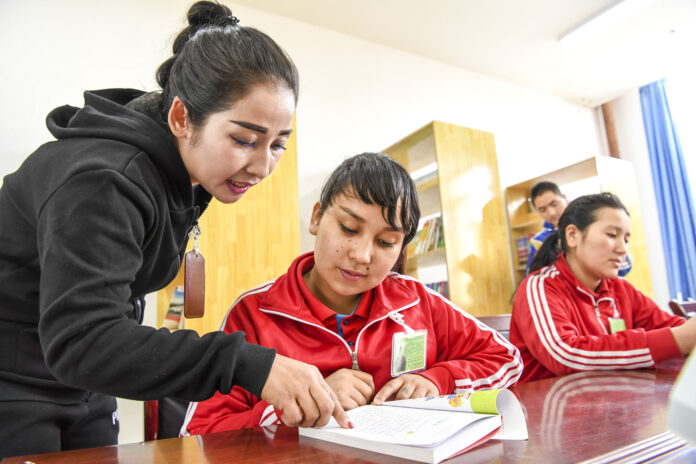Xinjiang lies in northwest China, bordering on Gansu and Qinghai provinces to the southeast and the Tibet Autonomous Region to the south, sharing a 5,000-km borderline with eight countries. It has an area of 1,600,000 sq km.
Xinjiang is home to many ethnicities including Uyghurs, Hans Kazakhs, Mongolians, Kirgiz, Xibe, Tajik, Uzbek, Manchu, Daur, Tartar, and Russian ethnic groups. China looks like a successful country when one talks about ethnic harmony and economic progress. The multiple diversities of China support each other which leads them towards economic prosperity.
Xinjiang, according to the Chinese government figures has had 15 successive years of good harvests with total grain output for the end of the year reaching 7.06 million tons.
The region’s relatively well-developed industrial structure focuses on a whole range of industries, such as textiles, foodstuff processing, leather, paper, sugar, carpets, raw and refined oil, iron and steel, metallurgy, machinery, chemicals, power generation, building materials, and the light industry. The tourist industry of the region is progressing; this was not possible in the violence-afflicted years of the region.
It took almost 20 years for the US to recognize ETIM listing as a terrorist organization as a strategic blunder. Therefore the USA revoked ETIM designation as a terrorist organization in November 2020. Such a policy after so many years raises multiple questions and brings confusion regarding US strategy towards WOT. The Chinese Foreign Ministry spokesperson Wang Wenbin said that the decision exposed the Trump Administration’s double standards towards counter-terrorisma
Unfortunately, according to the Chinese media starting around 2007, however, it became increasingly dangerous to visit Xinjiang. The region was rocked by a spate of horrific terrorist attacks, resulting in over 1,000 deaths and countless injuries. On July 5, 2009, there was a riot in the capital city of Urumqi; 197 people were hacked, beaten, or burned to death and 1,721 were injured. On 22 May 2014, two car bombings in the same city killed 43 people and wounded 94. There were dozens of other attacks.
The extreme violence was not just confined to Xinjiang. In 2013, five people died and 38 were injured in a suicide attack by three Uyghurs in Beijing. In 2014, a killing spree by eight knife-wielding Uyghurs left 31 people dead and 141 injured at a Kunming railway station. Most of the incidents were claimed by the East Turkestan Islamic Movement (ETIM). Later the successful Chinese anti-terrorism strategy brought peace back to this region.
Vocational Training Centres played a vital role in the Chinese war against extremism. As we know, employment is a key to a contented life. This is linked to the fundamental interests of the overwhelming majority of people. For this purpose, Xinjiang has set up several vocational education and training centres to provide systematic education and training to students. These measures improved their cultural knowledge and working skills, had them employed, or increased their income. The facility improved not only people’s livelihood and promoted employment, but also achieved social stability and long-term stability in Xinjiang. Remarkably, the training centres meet international standards and also are in line with the Counter-terrorism Law and the National Security Law of the People’s Republic of China.
But despite the successful policy of China to fight violence, the Western media is illogically busy in spreading fake news against vocational training centres and calling them concentration cells.
International relations analysts believe that with the rise of China there is evidence of a western-backed strategy to contain China. The anti–China elements use the human rights apparatus to defame China. Human rights are crucially important but when countries around the world raise selective issues for their own purpose this makes for abuse of the human rights apparatus. Overall the world has failed to protect human rights and there is an increasing trend of using related instruments for political aims and intervening in States’ domestic affairs.
The US and China supported each other in the War on Terror after the tragic events of 9/11. The USA and UN Security Council Al-Qaeda Sanctions Committee has listed the ETIM as a terrorist organization since 2002. But it took almost 20 years for the US to recognize ETIM listing as a terrorist organization as a strategic blunder. Therefore the USA revoked ETIM designation as a terrorist organization in November 2020. Such a policy after so many years raises multiple questions and brings confusion regarding US strategy towards WOT. The Chinese Foreign Ministry spokesperson Wang Wenbin said that the decision exposed the Trump Administration’s double standards towards counter-terrorism.
Whereas Pakistan and many other countries around the world do not agree with the Western narrative of the claimed atrocities done against Muslims in Xinjiang. Pakistan’ National Security Adviser Moeed Yusuf recently stated that Pakistan has good relations with China, and the Pakistani ambassador and other delegations have also visited the province of Xinjiang.
I think overall the stability and peace in Xinjiang itself is evidence of the vocational training center’s impactful role and success.























